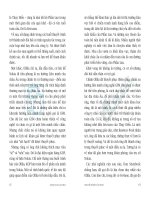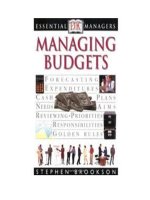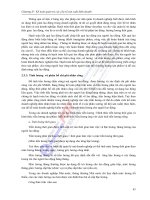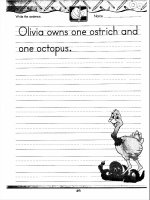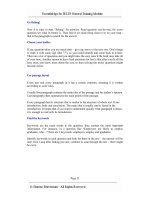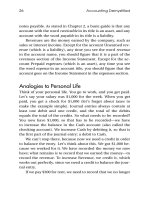THE MANAGING BUDGETS POCKETBOOK phần 3 pdf
Bạn đang xem bản rút gọn của tài liệu. Xem và tải ngay bản đầy đủ của tài liệu tại đây (152.05 KB, 11 trang )
FINANCIAL PLANNING
PLANNING FOR PROFIT
LINK TO THE MODEL
Now feed the sales budget and expenditure
budgets into the model.
21
CAPITAL
BUDGET
SALES
BUDGET
SOURCE OF FUNDS
USE OF FUNDS
SHARE CAPITAL LOAN CAPITAL RETAINED PROFITS
PRODUCTS / SERVICES
WORKING CAPITAL
Sales
Attributable Cost
Operating Profit
Interest
Tax
Earnings
Dividend
Retained Profits
Less:
Less:
Less:
Depreciation
FACILITIES / PROCESSES
FIXED ASSETS
REVENUE
BUDGET
REVENUE
BUDGET
SALES
BUDGET
CAPITAL
BUDGET
FINANCIAL PLANNING
PLANNING FOR PROFIT
HAVE YOU MADE A PROFIT?
Use your product costing system to determine:
- given your revenue budget
- what will be the budgeted cost of your products?
And having set your sales budget
- will you make a profit on the products you plan to sell?
Note: Product costing systems are explained in a later section of the pocketbook.
22
FINANCIAL PLANNING
PLANNING FOR PROFIT
FINANCING COSTS
You are now in a position to
complete the model by
feeding in the budget for
interest, tax and dividends.
Don’t forget to review the Source of Funds.
● Will you need additional share capital and/or loan capital?
● Have you remembered to adjust dividends/interest accordingly?
Repeat until the model is in equilibrium.
23
SOURCE OF FUNDS
USE OF FUNDS
SHARE CAPITAL LOAN CAPITAL RETAINED PROFITS
PRODUCTS / SERVICES
WORKING CAPITAL
Sales
Attributable Cost
Operating Profit
Interest
Tax
Earnings
Dividend
Retained Profits
Less:
Less:
Less:
Depreciation
FACILITIES / PROCESSES
FIXED ASSETS
24
FINANCIAL PLANNING
PLANNING FOR CASH
Businesses need cash in order to survive.
Without cash you cannot pay for materials, or labour, or services.
Without cash the profit-making machine will grind to a halt.
Profit is not the same thing as cash
● You must plan the cash as well as the profit.
● Many profitable businesses end up in liquidation!
● Therefore, just planning for profit is not good enough!
Note that the cash plan - the cashflow forecast - is an
integral part of the budget review process.
Never approve a budget plan unless the cashflow forecast
has been reviewed and is acceptable.
The business graveyard is littered with ‘successful’ businesses which ran out of cash.
Be warned!
The difference between profit and cash, and cashflow forecasting is explained in The Managing
Cashflow Pocketbook.
FINANCIAL PLANNING
EVALUATE THE OUTCOME
Now assess your plan. Is it good enough? Look at the expected outcome.
Will the plan enable the business to meet its financial responsibilities to its:
- owners: dividends, share price growth
- lenders: interest, capital repayments
- employees: wages, salaries, secure employment
- suppliers: payment, continued ‘partnership’
- customers: quality, availability, service, warranty
Will the result enable the business to progress towards its strategic aims?
If not go back to the drawing-board!
Remember this is a plan - if the expected outcome is unsatisfactory you have the chance
to redirect the business before it is too late!
25
26
FINANCIAL PLANNING
THE CHALLENGE PROCESS
You now submit (or formally present) your budget. Next comes the challenge process -
ideally carried out by a team who have not been involved in the previous stages.
● Is the budget consistent?
- have the same assumptions been used throughout?
● Are those assumptions valid?
● What are the critical success factors? What are the risks involved? ie:
- which events/outcomes are the key determinants in achieving the budgeted result?
● Are the budgeted returns worth the risks?
● Could you do better?
The budget may be re-worked many times before agreement is reached.
FINANCIAL PLANNING
CONTINUOUS REVIEW
The future is uncertain.
Planning enables the business to be proactive - but you
will still be unable to dictate your own destiny precisely.
Don’t bury your head in the sand!
Continuously review your plans:
- what new opportunities have arisen?
- new threats?
- what are the financial implications?
Managing a business requires you to be in control.
Being in control means you can respond to
changes in circumstances.
Keep looking forward!
27
FINANCIAL PLANNING
INTER-RELATIONSHIPS
The following sections of the book examine some of the key elements of
financial planning:
● Revenue budgets
● Capital budgets
● Product costing
Whilst these are often viewed as separate
exercises within the business, do not
overlook the complex inter-relationships.
For example, the decision to purchase a new machine will have a ripple effect, changing
the capital budget, revenue budget, sales budget (if customers buy more or pay more)
and cash budget.
View each of the budgets as part of the whole.
28
REVENUE BUDGETS
29
REVENUE BUDGETS
AIM
The Revenue Budget sets out the expenditure plans for the running costs of the business.
● What are we trying to achieve?
- an effective and efficient allocation of resources to achieve the company plan
● What do many businesses have?
- a discredited process which everyone ignores!
Why?
Recognise any of the following?
30
REVENUE BUDGETS
THE BUDGET SABOTEURS!
1 “Nobody asked my opinion even a half-wit should have realised that we’d need
extra maintenance work”
2 “You want me to set my budget? I’ve got customers screaming, suppliers on strike
say £10,000 and leave me to get on with my real job”
3 “My budget for next year? What have I spent this year?”
4 “I’ll need £9,000 I’d better add £1,000 for contingencies, and last year they cut all
budgets by 8%, so I’ll top it up by 10% just in case Tell them £11,000”
5 “If my budget gets smaller I’ll lose status in the organisation”
6 “That’s finished the budget then. Let’s pass it to the accountant and it’s her problem
for the next 12 months”
7 “If I don’t spend everything in my budget I won’t get as much next year”
8 “As long as I stay within budget, nobody will ask me any questions”
31
